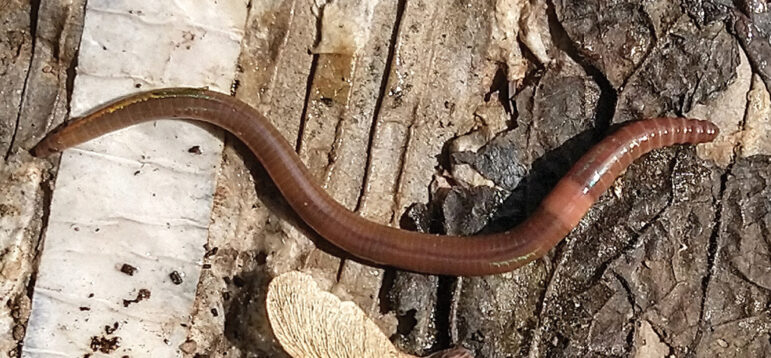Today, there are two kinds of gardeners. Gardener one has experienced an overwhelming, sickening infestation of jumping worms—shown here in a file photo.

Gardener two has not—yet.
There’s plenty we can do to throw obstacles in the path of this explosively expanding new invasive threat. (See the detailed description in my October 2023 column on the Drummer website or at GranbyInvasivePlants.weebly.com)
In May, the poppyseed-size cocoons, deposited by adult worms before they died in the fall, hatch after a string of days higher than 50 degrees. The hatchlings devour leaves, mulch and anything else they find in the top few inches of soil. By summer, they are large, energetic, snake-like wigglers with a distinctive milky band near their heads.
There’s no chemical cure at this time, though panicked researchers are working hard to find one. Dropping live worms one by one in a bucket of water with a bit of dish detergent kills them right away. It’s gross but worth it: each mature adult produces 100 more for next year.
Buying soil, compost, mulch?
Ask vendors if they can ensure their soil is free of jumping worm cocoons. Phone calls to a sample of nearby soil suppliers found not one supplier aware of and taking appropriate precautions to prevent the spread of jumping worms.
Buying or exchanging plants?
Ask nurseries and other plant sources what they do to guarantee plants are free of the nearly invisible cocoons. Unfortunately, the only way to be sure is to remove and wash all the soil off the roots, purify the removed soil and replant in worm-free soil.
Purify soil.
Whether you buy soil or wash it off purchased plants, here’s how to make it worm-free. Lay out plastic sheeting on a driveway in full sun. Spread the soil to a depth of less than six inches. Spread a second layer of clear plastic over the soil and—most important—fold and tape the two layers together all the way around so the worms cannot escape the heat. Leave it to steam and roast in the sun for several days. Soil heated to higher than 105 degrees over time kills the worms and destroys the cocoons.
Crazy, huh?
Yup. But taking these precautions might allow you to be Gardener #2. And that will make all the difference.
